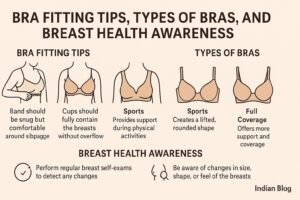When it comes to intimate apparel, bras are a crucial part of a woman’s wardrobe. However, most of us are unaware of the full form of BRA and its origins. In this blog, we’ll delve into the meaning of the acronym BRA and take a closer look at the history of this important undergarment.
The Full Form of BRA
The full form of BRA is Brassiere. It’s a French word that means “upper-arm protector.” The term “brassiere” was coined by Herminie Cadolle, a French designer who invented the modern bra in late 19th century. She wanted to create a more comfortable and supportive alternative to the corset, which was a popular undergarment at the time. Cadolle’s design featured two separate cups that supported each breast individually, and adjustable straps that allowed for a more customized fit. The term “brassiere” was first used in the English language in 1893, and it refers to a garment worn by women to support their breasts.
A Brief History of Bras
Before bras became a popular undergarment, women used corsets to support their breasts. However, corsets were uncomfortable and often caused health problems such as back pain, breathing difficulties, and even digestive issues. In the late 19th century, a French designer named Herminie Cadolle introduced a new garment that was designed to provide support to the breasts without compressing the waist or abdomen. This garment was called the corselet gorge, and it was the predecessor of the modern bra.
In the early 20th century, the bra as we know it today began to emerge. In 1914, a woman named Mary Phelps Jacob patented the first modern bra. Her invention was made of two handkerchiefs and a ribbon, and it was designed to be more comfortable than traditional corsets. The bra became popular during World War I, when women began to take on jobs that required more physical activity. The corset was not suitable for these jobs, and so the bra became the preferred undergarment for women.
Since then, the bra has undergone numerous changes in design and construction. Today, there are many different types of bras, each designed to meet specific needs. Some bras are designed for support, others for comfort, and still, others for aesthetics.
The full form of bra is Brassiere which is an important undergarment that has a rich history dating back to the late 19th century. From its early beginnings as the corselet gorge to the modern bras of today, the bra has undergone many changes in design and construction. Regardless of its design, the bra remains an essential part of a woman’s wardrobe, providing support and comfort to the breasts. Now that you know the full form of BRA and its history, you can appreciate the importance of this undergarment even more.
Types of Bras
As mentioned above, there are many different types of bras, each designed to meet specific needs. Here are a few examples of some of the most common types of bras:
- T-shirt bra: This type of bra is designed to be seamless and invisible under tight-fitting clothing, making it a great choice for everyday wear.
- Sports bra: Sports bras are designed to provide maximum support during physical activity. They are typically made of breathable, moisture-wicking materials that help keep you cool and dry.
- Push-up bra: Push-up bras are designed to lift and enhance the appearance of the breasts, making them appear fuller and more rounded.
- Strapless bra: Strapless bras are designed to be worn without straps, making them a great option for strapless dresses and tops.
- Nursing bra: Nursing bras are designed to make breastfeeding easier and more comfortable for new mothers. They typically feature easy-to-open flaps that allow for quick and easy access to the breasts.
The bra is a versatile and important piece of clothing that has evolved over time to meet the changing needs of women. Whether you need a bra for support, comfort, or aesthetics, there is a style out there that is perfect for you. By understanding the history and different types of bras available, you can make an informed decision when it comes to choosing the right bra for your needs.
Bra Fitting
While choosing the right type of bra is important, it’s equally essential to ensure that it fits properly. A poorly fitting bra can cause discomfort, back pain, and even damage to breast tissue. Here are a few tips for getting the right fit:
- Measure yourself: Use a tape measure to measure around the fullest part of your bust and just underneath your breasts. This will give you an accurate measurement of your bra size.
- Check the fit: When trying on a bra, make sure that the band fits snugly around your ribcage, and that the cups provide full coverage of your breasts without any bulging or gaping.
- Adjust the straps: The straps should be adjusted so that they provide support without digging into your shoulders.
- Try on different sizes and styles: Not all bras are created equal, and different styles may fit differently. Try on a few different sizes and styles to find the one that works best for you.
Proper bra fitting is crucial for both comfort and breast health. If you’re not sure how to get the right fit, consider visiting a lingerie store and getting a professional fitting. They can help you find the right size and style of bra to meet your needs.
Bras are an essential part of a woman’s wardrobe that has evolved over time to meet the changing needs of women. From their early beginnings as the corselet gorge to the modern bras of today, the bra has come a long way. By understanding the full form of BRA and its history, the different types of bras available, and the importance of proper bra fitting, you can make an informed decision when it comes to choosing the right bra for your needs.

